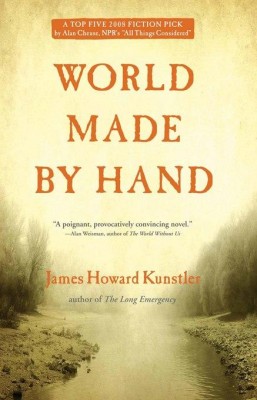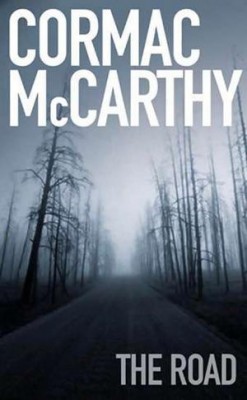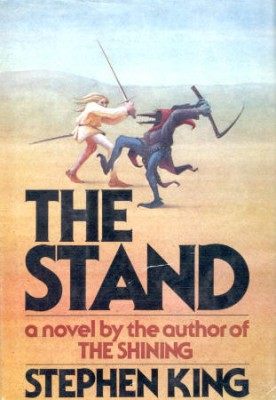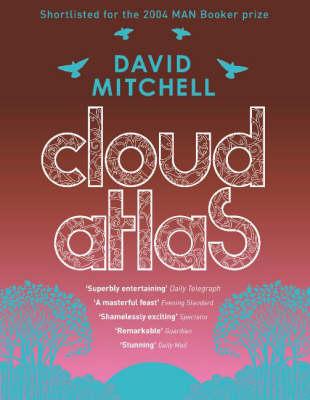THE MAYAN APOCALYPSE, like Y2K before it, was a bit of a bust. That’s great, of course. We sort of knew it would be another bit of empty, fear-mongering hype. Nevertheless, some of us indulged in delicious worrying and intensified speculation about how the End of Days would, or could, go down, and how life might be afterwards.
Regardless of what was augured centuries ago, doomsday fiction devotees like me think about this stuff all the time. And we are legion. As noted by The Weeklings’ own Samuel Sattin, the post-apocalyptic / dystopian genre enjoys unprecedented popularity, thanks in no small part to my dollars.
Sometimes friends ask, “Why do you read that shit?”
Personally, I go for the clarifying aspect of apocalyptic fiction, the notion that crisis reveals truth. Fran Leibowitz once said, “The term ‘child actor’ is redundant,” but I would go one further: I believe we’re all acting, almost all the time. In order for civilization to function, we must keep to our respective, super-ego bolstered roles. Until there’s no civilization, and it’s all id, all the time. With every YouTube-documented disaster, both man-made and otherwise, this thesis gains gravitas. I’ll never forget my own rural town in the wake of Irene, off the grid for a week or so, overrun by National Guardsmen with automatic weapons; folks normally confined to the shadows ventured out, oftentimes in hunting gear, Second Amendment strong, Apocalypse-ready. The lyrics to Leonard Cohen’s “First WeTake Manhattan” kept ringing in my head: “How many nights I prayed for this, to let my work begin / First we take Manhattan, then we take Berlin!”
Literally translated, the word apocalypse means “a revelation,” or “uncovering,” as in uncovering of the truth. (From the Greek: apo, meaning un, and calypto, meaning covering.) In fact, the title of the New Testament Doomsday guide, John of Patmos’ first century CE “Book of Revelation,” is Apokalypsis. In other words, through crisis, the End of Days reveals The Truth of the World while also revealing us to ourselves.
So ask yourself: how attached is your personality to creature comforts, culture, habits? Like a sauce bubbling down, clarifying on a stove, what will be left of your persona when the extraneous elements boil away in the heat of trouble? For me, these questions are pistons in the engine of apocalyptic and post-apocalyptic stories. If my mood is good, I’ll recall the saying, “People are at their best when things are worst.” Conversely, the blues will produce the jolly aphorism, “We’re all only five meals away from murder.”
Finally, I savor the luxury of being able to choose the crisis, then let it go. With expanded awareness, I enjoy a deepened appreciation of plumbing, central heating, and potable water. On a good day, I allow a bubbling hope that leaders will heed the cautionary tales; I allow the vision of future generations looking back and laughing at our harebrained notions, our lousy CGI, our faithless fears, and not cursing our cowardice and willed ignorance.
With that shred of optimism in mind, we begin this list with the most hopeful of all the post-apocalyptic books, and, perhaps not coincidentally, the only one on the list without an accompanying movie… yet.
~
1. World Made By Hand by James Howard Kunstler, 2008
Before this book – the first in a four-part series – Kunstler penned nonfiction jeremiads The Geography of Nowhere and The Long Emergency. These predict an imminent civilization bereft of oil, and the subsequent effect on social order, government, transportation, communications, food production, etc. World Made By Hand gives life to this vision.
Fifteen or so years before the first chapter opens, nuclear terrorist attacks on D.C. and L.A. have hastened the Collapse. The attacks have effectively shut down the country; millions are dead via nukes and subsequent epidemics. A wobbly world economy has long since imploded, and suburbs, strip malls, etc., have been abandoned by all but the intrepidly insane. The president is in Minnesota, or at least that’s what they say. Race riots ravage the southern states. (There are no people of color in WMBH.) All roads are impassable except by horse or on foot. No working combustible engines anyway.
Kunstler zooms in on an unseasonably hot summer – hello, climate change – in upstate NY’s Union Grove, a former 19th century farm town turned neo-hippie commune-cum-serfdom. Towns built in the days before sprawl survive by reverting to the Old Ways.
Kunstler gives no exact years, but protagonist Robert Earle, unofficial mayor of Union Grove, is a former software designer. His wife died of superflu, his teen son ran away, and he gets by with fishing, carpentry, and barter. His best friend’s wife – one in a series of poorly drawn women – frequently visits with a corn cake, and they engage in loveless sex, which the best friend allows. Moral codes, dependent on comfort, are shaky; conceits of honor and neighborliness are just hanging on, until they’re not.
Scavenging, murderous redneck neighbors and the arrival of the neo-Amish-meets-free-love religious cult the New Faith Order introduce conflict and a little magical realism, creating a narrative around which Kunstler hangs his prophecy.
Kunstler details dress, language, music (rednecks love Metallica, Union Grove folks love bluegrass) and food, offering Dutch ovens, rhubarb jam, and cheese making. This is the only post-Apocalyptic novel that’ll make you hungry. As in pre-industrial days, sustenance depends on the landscape, which in upstate NY, means plentiful dairy, plus corn, vegetables, apples, fish, and small game. Kunstler’s characters bake pies, concoct stews, smoke pot, dance, and screw.
Let’s hope so.
THE VIDEO (on Kunstler’s own YouTube channel): Well-chosen bits of dialogue flesh out the story, but folks look a little too apple-cheeked and healthy, I think.
2. The Road by Cormac McCarthy, 2006
On the opposite end of the spectrum, we have The Road.
“What’re you reading?”
“The Road.”
“How is it?”
“I hate it. But I can’t stop reading it.”
The plot couldn’t be simpler: An unnamed disaster in a not-too-distant future has stripped our fair Earth of her biosphere; a terminally ill man and his preteen son head south to escape a lethal winter, all the while hiding from roving bands of cannibals. The wife/mother has committed suicide, a common occurrence. There’s virtually no food left, no animals, no crops. Think about it. The only thing to eat, aside from rare scraps, is people. The cannibals are somewhat organized, even down to harvesting imprisoned humans. Sounds horrible, I know. Yet McCarthy’s exquisite prose renders the mind-numbing depravity plausible, and, in authorly derring-do, riveting.
Perhaps less is more, because The Road is the only book on this list to win the Pulitzer for fiction. It’s a marvel of subtext. No warnings, no politics, no arguments, no fists at the sky, yet it conveys a Zen-like prophetic power, straddling the line between resonant myth and speculative fiction.
The book is mostly in third person, and the characters have no names, just “the man,” and “the boy,” or “the father” and “the son.” The father’s every action, even some harrowing cruelty, is aimed at protecting his son, keeping life alive, teaching how “the good guys” act, and most important, how to survive in this dying world after he, the father, bites it. The son, born on the eve of “The Event,” knows only hunger, running, and his father’s love. At one point he finds a Coke and is amazed at the nectar of the dead gods.
McCarthy received kudos from environmentalists; “It will change the way you see the world,” “McCarthy is one of 50 people who could save the planet.” He says he wrote the book for his four-year-old son, transcribing some of their conversations during a trip toEl Paso, when he imagined fire on the horizon while his boy slept.
In a surprising move, the cantankerous, publicity-shy McCarthy slumped in a comfy chair across from Oprah, and talked movingly about fatherhood, even blushing when Oprah asked him if The Road was a love story for his boy.
THE MOVIE: Critics liked it better than audiences. It’s brutal, pulls no punches. The only post-apocalyptic flick – finally – where everyone is filthy, skinny, sunken-eyed, and brown-toothed. Viggo Mortensen is superb; desperate, angry, but also tender. The settings are nightmare gray, and the roving cannibals are scarier than any zombies, because they are ordinary folks reduced by circumstance to reptile-brain-dominant sociopaths.
3. The Stand by Stephen King 1978, re-released unabridged 1990
The Stand is King’s Lord of the Rings, almost the Bible for post-apocalyptic fiction fans, and one of the longest books I’ve ever read (1152 pages). To his great credit, King, unlike any other author on this list, undertakes, in excruciating, fascinating detail, the precipitous Fall itself, which is set in 1990 (originally in 1980, later revised.) The first third, Captain Trips, opens with a military policeman barely escaping a gated facility where a highly communicable, lethal super virus, manufactured as a weapon, has mutated and broken out of containment. He doesn’t know he’s the Typhoid Mary of the end of the world. The trajectory of the virus, which takes about three weeks to decimate 99 per cent of Earth’s population, is a dizzying bit of ensemble-cast storytelling, and the best part of the book. Everything feels spookily plausible: denial, media cover-up, realization, panic, hostile takeovers of TV and radio stations, martial law, and finally, unspeakable madness and chaos in the streets as almost everyone keels over.
A chosen few possess immunity to the virus, and this disparate group seeks to remake the world. Characters inclined by disposition toward “good” receive lucid dreams of 108-year-old Abigail Freemantle calling them to gather in Boulder, Colorado, and start over. Meanwhile, folks inclined toward “evil” receive visions of a Dark Man with supernatural powers named Randall Flagg, who is setting up his own version of Fascism in Las Vegas. Flagg aims to destroy the upstart democracy in Boulder. In King’s world, inchoate forces both destructive and creative swirl in the ether, manifesting in some as impulses and in others as complete personalities.
While he tends toward tired tropes (Magical Negro Abigail Freemantle and Inspirationally Disadvantaged Tom Cullen), King excels at multi-character development, dialogue, and keeping a ridiculous array of balls in the air. Even though the book loses steam as everything plays out, The Stand is still a worthwhile read.
THE MOVIE: After an aborted Warner Brothers production, The Stand became a six-part, six-hour miniseries on ABC in 1994, with a teleplay by King himself. It starred Molly Ringwald, Rob Lowe, Ruby Dee, Gary Sinise, Ed Harris, Kathy Bates, and Kareem Abdul-Jabbar (!!). Although toned down for prime time, occasionally hokey, and very nineties (mom jeans! pleated pants!), it’s also surprisingly good in spots. Like the book, however, it’s a big commitment. At this writing, Ben Affleck has signed on to direct a feature film, likely in three installments, and likely very, very graphic.
4. Cloud Atlas by David Mitchell, 2004
Technically, only the middle part of this remarkable book, Sloosha’s Crossin’ an’ Evrythin’ After, is post-apocalyptic, set in 2321 (date according to the Internet, not Mitchell).
Mitchell asks a lot of readers in Cloud Atlas, and especially Sloosha’s Crossin’, for which he invents an English patois reminiscent of both A Clockwork Orange and Amos ‘N’ Andy. But as with the whole of Cloud Atlas, once your brain attunes to it, it’s like a song. Protagonist Zachry tells a campfire story, and by degrees we discover he’s a goat herder in a ragtag, primitive tribe on the island of Ha-Why/Hawaii, and the Earth is decades past The Fall, the details of which are lost to time. No one knows what caused it, but our species’ storytelling urges are powerful as ever, and the denizens of Ha-Why have invented gods. The Agent of Destruction, who “tripped the Fall,” is Old Georgie. The Goddess of Life, worshiped and prayed to, is Sonmi, i.e., “For Sonmi’s sake, hurry up.”
Cannibals menace Zachry’s tribe on one side of the island, while the Prescients visit them on the other. The Prescients are advanced humans, fellow survivors of The Fall, visiting once a year or so, arriving by fusion-powered craft to trade and observe; one of them, Meronym, decides to stay, ostensibly for anthropological reasons. Meronym’s tribe forbids her to interfere overmuch with Zachry’s people, but crisis intervenes, and she breaks the rules of engagement. She informs Zachry, to his amazement, that “Old Georgie” didn’t trip the Fall, humans did; although “the Old ‘uns” had “big smart,” they also never tamed their hunger for more. Meronym’s people, in fact, are searching the globe for terrain that hasn’t been “deadlanded.”
Unlike the stereotypes in The Stand, Zachry is a complicated microcosm of humanity, curious to know more, yet afraid to let go of comfortable, familiar superstition; beholden to innate impulses both destructive and creative, suspicious of power, yet drawn to it; filled with haunting cowardice and life-saving courage. As with The Stand, the fate of the human race boils down to the actions of one man who doesn’t know it. It’s gripping stuff.
THE MOVIE: Appreciated more by critics than audiences. You gotta give it up to producer-directors the Wachowskis, though, for trying to film an essentially unfilmable, multileveled, time-shifting story. Although the outside input sometimes irritated me, Cloud Atlas is still a soulful, worthwhile film. While Zachry (Tom Hanks) and Meronym (Halle Berry) are not star-crossed lovers in the book, the Wachowskis introduce some carnality to the relationship. (It is Halle Berry, for Sonmi’s sake.) The cinematography is stunning; sun-damaged neo-savages in woven garments; wrecked futuristic architecture; occasional detritus of “the Old ‘uns.” Suitably thought-provoking.
~
Back in the real world, we wonder. Sometimes kindness reigns, and the more optimistic scenarios ring true. Other days, unbearable suffering wrought by fellow humans clouds the spyglass and our more pessimistic latter-day John the Revelators seem prophetic indeed.
The beauty of a cautionary tale, however, is that it is a tale, wrought by creative power. As Ebenezer Scrooge asks of the silent, spectral Spirit of Christmas Future, “Are these the shadows of things that MUST be, or are they only the shadows of things that MIGHT be?”
At this point, we are like Scrooge, who is given no answer, but a choice.







Pingback: I Am A Weekling | solitude & good company
Wonderful review of these four books@ I’ve read Cloud Atlas and The Stand, though have hesitated to open The Road for nearly a decade now, and have only vaguely heard of World Made By Hand before. I think the one post-apocalyptic book that probably kicked me in the gut the most was On the Beach. Even if it’s sentimental and maybe a bit outdated by today, the overwhelming sense of impending extinction kept my 15-year old brain at the time transfixed.
Hey Miles,
Thank you so much. People have been recommending On The Beach to me for years. I must add that to my list, which also includes Earth Abides. One that I recently read that I highly recommend is Station Eleven. All of the above will make it into Post Apocalyptic Reader II. That is my solemn promise.
Thanks again – RBW